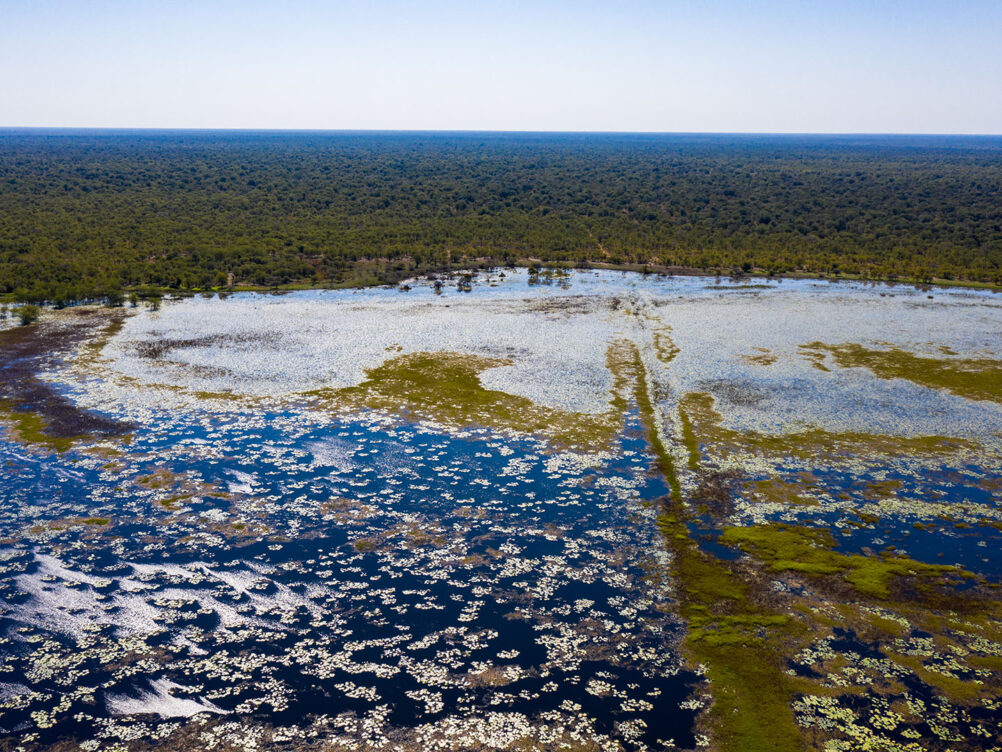Deep in the heart of Mozambique’s Gaza province lies Banhine National Park, a remote and untamed wilderness shaped by the rhythm of seasonal floods and shifting sands. This vast landscape, named after its inland delta, is a sanctuary where water, wildlife, and people are intricately connected. As the rains arrive, the park’s shimmering wetlands stretch over 500 km², a welcome refuge for thousands of migratory birds.
But Banhine is also a land of contrast—an arid region where rain is scarce, with only 400 to 430 millimetres falling each year. The seasonal wetland, therefore, is more than just a spectacle of nature; it is the pulse that sustains life in an otherwise dry land.
A symphony of wings

For bird lovers, Banhine is nothing short of a paradise. From the towering ostriches and regal ground hornbills that stride across the grasslands to the eagles that survey the sky, every corner of the park echoes with avian life. Yet, it is the wetland that hosts the park’s most spectacular visitors.
When the floodwaters settle, an orchestra of calls fills the air as reed cormorants dart across the lagoons and black-crowned night herons hunt in the shallows. White-faced whistling ducks and pygmy geese bob along the water’s surface, while flocks of greater flamingos and great white pelicans arrive as the wetland’s salinity shifts. With an impressive 282 bird species recorded, Banhine is an integral link in the migratory network that spans the African continent.
Life finds a way
Banhine’s landscapes are a mosaic of ecosystems, from the open grasslands that surround the delta to towering mopane woodlands, ironwood forests, and groves of ancient baobabs. These habitats once teemed with herds of zebra, wildebeest, tsessebe, giraffe, and elephants, their migration routes tracing ancient pathways between Kruger National Park and the greater Limpopo Transfrontier Conservation Area.
Decades of conflict in the 20th century took their toll, but nature is resilient. Aerial surveys in 2023 confirmed a growing presence of elephants, buffalo, and ostriches, with impala, kudu, and nyala finding refuge in the park’s southern woodlands. The whispers of a recovering ecosystem are getting louder—lions, leopards, and hyenas are making their return, reclaiming their place in the delicate balance of predator and prey.
Following the giants
Thanks to collaboration with the Mozambique Wildlife Alliance, Banhine has gained a unique window into the lives of its wandering giants. Five collared elephant bulls have revealed fascinating insights into transboundary wildlife corridors. Between October 2023 and February 2024, four of these bulls ventured from Banhine into Limpopo National Park, each following near-identical routes under the cover of darkness. One continued his journey all the way to South Africa’s Kruger National Park before making his way back.
Their synchronised movements highlight the importance of protected corridors, ensuring that these elephants—and countless other species—can move freely across the landscape. By April, all four bulls had returned to Banhine, proof that this park is not only a sanctuary but a vital part of a much larger ecological puzzle.
Strengthening communities, strengthening the future
Surrounding Banhine, some of the world’s most remote and underserved communities rely on the park’s support. Since 2015, Peace Parks Foundation’s community development program has grown from assisting 200 individuals to impacting nearly 14,000 lives by 2024.
Water, the most precious resource in this parched landscape, has been made accessible through boreholes, while conservation agriculture projects are changing lives. “I’m proud to be part of the Phunekane Association,” says Ana Marta Francisco Chaúque. “We’ve learned new techniques that help water circulation and improve our crops. This initiative is helping us tackle food insecurity.”
A new chapter for Banhine

With a renewed focus on conservation, Banhine National Park is preparing for its next great transformation thanks in large part to anchor donors the COmON Foundation, who provide generous funding of EUR 500 000 per year. Infrastructure improvements have modernised park facilities, enhanced ranger stations, and installed a welcoming entrance for future ecotourism. Anti-poaching efforts, have shown remarkable success with extremely low poaching levels reported in 2024.
”Banhine is undoubtedly one of the most pristine landscapes in Mozambique, located at the heart of the Great Limpopo Transfrontier Conservation Area. One day, it will be the centerpiece of the Bush to Beach experience, linking the Kruger National Park in South Africa to the coastlines of Mozambique. The wetlands at the core of Banhine may be even more remarkable than the Okavango Delta. The birdlife is abundant beyond measure, and the landscape simply touches the soul,“ says John Loudon, MD of the COmON Foundation.
The next step? Rewilding, to breathe life into the park’s ecosystems and create new opportunities for local communities. In 2025, the first translocations of wildlife will begin, a milestone in the park’s restoration. A generous EUR 100,000 grant from the German Postcode Lottery to Peace Parks Foundation will support water provision, access road opening and a sanctuary for incoming animals.
A race against time

Across the globe, wetlands are disappearing at an alarming rate—35% have been lost in just 50 years, vanishing three times faster than forests. Meanwhile, sub-Saharan Africa’s population is set to double by 2050, placing unprecedented pressure on land and resources.
Yet, places like Banhine, managed by Mozambique’s National Administration for Conservation Areas (ANAC) in co-management partnership with Peace Parks, offer hope. Conservation is not just about protecting wildlife and wetlands for our common future; it’s about securing the future for people, landscapes, and the delicate systems that sustain life. As Banhine rises once more, it stands as a testament to resilience, collaboration, and the power of nature to heal when given the chance.
Watch this space—Banhine’s greatest adventure is just beginning.





